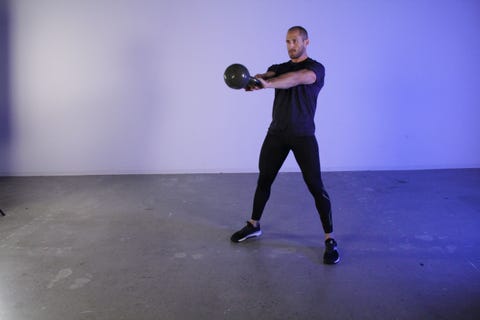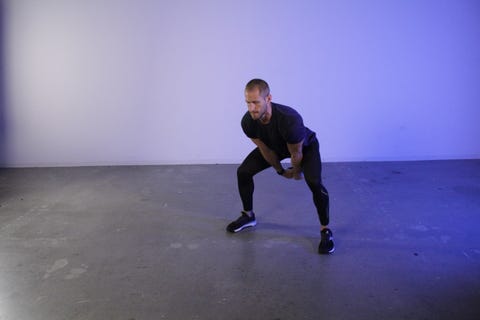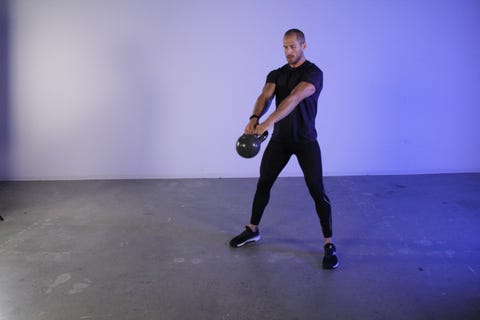How to Do a Kettlebell Swing the Right Way
The kettlebell swing is a core training staple that can help to build total body strength and power, but are you sure you’re even doing the exercise correctly?
For this explosive movement, you shouldn’t settle for anything other than perfect form—especially because it’s such a simple, essential exercise that should serve as one of the centerpieces of your training plan. Let Men’s Health fitness director Ebenezer Samuel, C.S.C.S. and associate fitness editor Brett Williams guide you through the move’s subtleties, saving you from the bad habits that are keeping you from unlocking your fitness potential.
Before you pick up a weight and start waving it around, take note that it’s extremely important to pay attention the movement here. The way that you start your swing position is essential, as is your body’s posture throughout—so let’s break down everything you need to know.
What is the Kettlebell Swing?
Eb says: The kettlebell swing is all about hinging at your hips. Even more than that it is a move that lets us explosively express what’s called “hip extension.”
If you’ve ever jumped, or gone for a run, or worked even simply just stood up from a chair, you’ve done a form of hip extension. If you do those things right (and because we increasingly sit so much, we occasionally do it wrong), you’re squeezing your glutes and your lower body is driving your ability to stand up. This action is crucial to moving and standing correctly, and critical to improving your athleticism (and your squat and deadlift movements).
What the Kettlebell Swing Is NOT
Not a Squat to Front Raise
Eb says: Bodybuilders tend to do kettlebell swings like this, because they’re breaking the motion back into two bodybuilding motions. This doesn’t just miss the point of a kettlebell swing (hip extension) but it’s dangerous for your shoulders, too. You end up trying to finish the swing with your shoulders, placing your rotator cuff tendons in a compromised position.
Not a Romanian Deadlift Swing
Eb says: This is a bodybuilding motion and comes from a tendency to not bend your knees, or at least to not bend them enough. The hamstrings work best when they let you bend at the knee and hip together. Eliminating one limits your ability to be explosive, as you should be during kettlebell swings.
Not a Swing to a Target
Eb says: When you start swinging to a target, you start trying to involve your shoulders, which can again compromise them. In truth, the height of the kettlebell doesn’t matter. The height of the kettlebell is strictly a function of how aggressively you straighten your legs and squeeze your glutes.
Not as American as Apple Pie
Eb says: The American kettlebell swing has you swinging to a wildly high target (overhead) and that’s problem one. Problem two: if your shoulder mobility isn’t ideal; you’ll compensate by arching through the lower back. That’s a lower back injury waiting to happen.

Tony Xie/Men’s Health
Swing Cues
Upper Body Tense
Eb says: Your upper body isn’t the driver of the kettlebell swing; it’s only a lever. But we still want it to be a sturdy lever. So you need to tighten up your core and set your lats.
Never Round
Eb says: This goes back to tight core. One common flaw you’ll see when people do swings is they’ll round through the upper back or (worse) through the lower back. You absolutely must maintain the stiffness through your torso over the life of your swing set. That’s about keeping abs tight and lays tight.

Tony Xie/Men’s Health
Body Follows Bell
Eb says: Don’t think of bending at the waist to create the swing. Focus on letting the bell drive you to bend your waist. Your arms will rise because the bell exploded forward and upward. As it comes back, let the bar drag your biceps to your torso, and then let the bell pull your torso downward. This will help insure a rigid torso.
Arms Like Rope
Eb says: This is a lower body move, and your arms shouldn’t be anything more than a lever for the bell. You don’t want to get in the habit of having them drive the lift. To avoid that think of your arms just like rope. Keep them loose and fully relaxed. All they’re going to do is translate the momentum you generate with your legs and glute squeeze.

Tony Xie/Men’s Health
Just Stand Up and Squeeze
Eb says: The kettlebell swing is all about aggressive explosion and countermovement but, much like a jump, the actual motion creating the explosive action is much smaller than you may think. You really need to think about two things when you are trying to explode the bell upwards: stand up and squeeze your glutes. Don’t think of it as a swing. If you explosively and powerfully stand up, and really exaggerate that glute squeeze, your torso will naturally pop up and the bell will translate forward.
Squeeze Those Glutes
Eb says: Critical in the kettlebell swing is not letting your lower back drive the movement. It’s your glutes that drive you to stand up. If you’re having trouble getting that response, think of actively squeezing your glutes to drive the bell. It should be a powerful glute squeeze, as if you’re doing a hip thrust. Work hard to really feel your glutes.
Breathe!
Eb says: Exhale forcefully as you power the kettlebell out of the hole. Remember: this is an explosive motion. Exhaling will help you channel that power.
Source: Read Full Article


